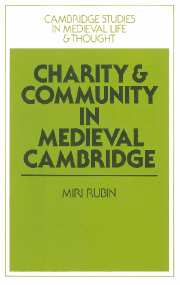Book contents
- Frontmatter
- Contents
- List of tables
- Acknowledgements
- List of abbreviations
- Map
- 1 INTRODUCTION
- 2 THE ECONOMIC BACKGROUND: SUPPLY AND DEMAND FOR CHARITY
- 3 THE IDEA OF CHARITY BETWEEN THE TWELFTH AND FIFTEENTH CENTURIES
- 4 THE CHARITABLE HOUSES OF MEDIEVAL CAMBRIDGE AND ITS SURROUNDINGS
- 5 LIFE IN A MEDIEVAL HOSPITAL: THE HOSPITAL OF ST JOHN, CAMBRIDGE
- 6 THE RELIGIOUS AND ECONOMIC FUNCTIONS OF THE HOSPITAL OF ST JOHN
- 7 CORPORATE AND INDIVIDUAL ACTS OF CHARITY
- 8 EPILOGUE
- Appendix 1 The rule of the hospital of St John the Evangelist, Cambridge
- Appendix 2 The list of masters of the hospital of St John the Evangelist, Cambridge (c. 1207–1507)
- Bibliography
- Index
6 - THE RELIGIOUS AND ECONOMIC FUNCTIONS OF THE HOSPITAL OF ST JOHN
Published online by Cambridge University Press: 28 October 2009
- Frontmatter
- Contents
- List of tables
- Acknowledgements
- List of abbreviations
- Map
- 1 INTRODUCTION
- 2 THE ECONOMIC BACKGROUND: SUPPLY AND DEMAND FOR CHARITY
- 3 THE IDEA OF CHARITY BETWEEN THE TWELFTH AND FIFTEENTH CENTURIES
- 4 THE CHARITABLE HOUSES OF MEDIEVAL CAMBRIDGE AND ITS SURROUNDINGS
- 5 LIFE IN A MEDIEVAL HOSPITAL: THE HOSPITAL OF ST JOHN, CAMBRIDGE
- 6 THE RELIGIOUS AND ECONOMIC FUNCTIONS OF THE HOSPITAL OF ST JOHN
- 7 CORPORATE AND INDIVIDUAL ACTS OF CHARITY
- 8 EPILOGUE
- Appendix 1 The rule of the hospital of St John the Evangelist, Cambridge
- Appendix 2 The list of masters of the hospital of St John the Evangelist, Cambridge (c. 1207–1507)
- Bibliography
- Index
Summary
As a charitable institution existing within a town, sustained by properties in it and by the patronage of burgesses, the hospital's fortunes were affected by the changes in the urban environment and the town's prosperity, its life-style and religious orientation and in attitudes towards charity entertained by townsfolk. Changes in the hospital's functions and services to society can thus betray shifts in the spiritual aspirations of the host community, and also help us reveal the objectives that houses like HSJC were expected to fufil.
CHANTRY SERVICES FOR BENEFACTORS
Religious houses induced and responded to patronage by offering a perpetual flow of prayer. Theirs were the prayers of the ordained living a pure and rigorous life. Hospitals could additionally offer the grateful prayers of Christ's poor, and leper houses of those afflicted and humble. The expectation of spiritual reward did not diminish the penitential value of charitable acts. In a letter authorising collections of alms for hospitals Pope Innocent III explained this value:
Since, as the Apostle said, we shall all stand before Christ's tribunal, to receive as we had merited in life… we must anticipate the day of final harvest with works of mercy… And since the hospital's resources do not suffice for the brethren and poor flowing to it, we warn and exhort you all in the Lord, and enjoin for the remission of your sins, that you bestow some of the goods given to you by God to pious alms as charitable aid to them… so that you can arrive at eternal joy.
- Type
- Chapter
- Information
- Charity and Community in Medieval Cambridge , pp. 184 - 236Publisher: Cambridge University PressPrint publication year: 1987



